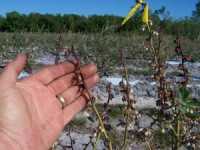Blueberry Report: Managing Micronutrients

When it comes to plant nutrition, there are about 16 different elements that are considered critical to the survival and growth of a crop. Each of these elements serves a different purpose, and based on the crop or region, the level of detail you need to know about your plant’s nutrient status will vary.
In blueberry production, the most limiting or most commonly deficient elements can be broken down by primary, secondary, and micronutrients.
– Primary elements: nitrogen, phosphorus
– Secondary elements: magnesium
– Micronutrients: iron, copper, boron, manganese
Proper management of these nutrients starts with monitoring your field. At least once a year, you should take soil and media samples to check pH and soil nutrient levels. You should also take leaf samples to make adjustments in fertilizer rates. These samples can be collected at least twice a year, during preharvest and postharvest periods. Recently matured leaves are the best for analysis. Contact your local Extension office for assistance in soil and leaf sampling.
Common Deficiencies
Each of the critical micronutrients will demonstrate noticeable signs when they reach deficient levels. Here’s a review of what to look for.
– Iron deficiencies appear most often in soils with a pH above 5.3. Deficiencies are often seen during drought periods on shoot tips using high pH irrigation water or in wet spots. The best long-term treatment is with acid injection to keep the irrigation water at a pH of 5.0 to 5.5. Elemental sulfur also works well if applied proactively. Soil applications of iron chelate may also work. Foliar application of iron sulfate or iron chelate may also be a solution.
– Copper is an increasing problem on some soils. Symptoms include dieback and small mouse ear shoots in late summer. This deficiency can be treated with copper chelate or copper sulfate (use copper chelate if sulfur water is present). You can diagnose sulfur water by mixing copper sulfate with irrigation water in a bucket. If it forms cloudy material, use copper chelate instead of copper sulfate.
Note that copper deficiencies can cause dead shoot tips, as well as stem blight the following spring. Stem blight has been a very serious problem on some blueberry farms in Georgia the past couple of years; it moves rapidly down the stems and can kill the plants.
– Manganese can sometimes be found at an excessive level. Excess manganese is often found in pine bark and in soils with low pH levels. Watch for red leaves and defoliation. In some cases, a combination of fertilizer with manganese plus low pH has led to toxicity.
| The chart below indicates suggested critical nutrient levels measured in parts per million in highbush and rabbiteye blueberry leaves. Be sure to take leaf samples so you can make adjustments in fertilizer rates if necessary. | ||||
| Element | Deficiency Below % | Minimum (%) | Maximum (%) | Excess Above (%) |
| Nitrogen (N) | 1.70 | 1.80 (1.20) | 2.10 (1.70) | 2.50 |
| Phosphorus (P) | 0.10 | 0.12 (0.08) | 0.40 (0.17) | 0.80 |
| Potassium (K) | 0.30 | 0.35 (0.28) | 0.65 (0.60) | 0.95 |
| Calcium (Ca) | 0.13 | 0.40 (0.24) | 0.80 (0.70) | 1.00 |
| Magnesium (Mg) | 0.08 | 0.12 (0.14) | 0.25 (0.20) | 0.45 |
| Sulfur (S) | 0.10 | 0.12 (NA) | 0.20 (NA) | NA |
| ppm | ppm | ppm | ppm | |
| Manganese (Mn) | 23 | 50 (25) | 350 (100) | 450 (125 max.) |
| Iron (Fe) | 60 | 60 (25) 40 | 200 (70) | 400 |
| Zinc (Zn) | 8 | 8 (10) | 30 (25) | 80 |
| Copper (Cu) | 5 | 5 (5) | 20 (10) | 100 |
|
Boron (B)
|
20 | 30 (12) | 70 (35) | 200 |
Start With The Soil
Proper management of nutrient levels begins with focusing on the soil or media chemistry. The soil or media pH should be between 4.0 and 5.3, with a primary target range of 4.5 to 4.8.
Acid injections are widely used if pH or bicarbonates are very high. Typically sulfuric acid, or urea sulfuric acid, is used to lower the pH to 5.0 to 5.5 for blueberry irrigation water. If the pH of your irrigation water is very high, and you use drip irrigation, iron chlorosis can develop quickly, even in soils with initially low pH levels. Sodium can also be a problem, and it is toxic to blueberries at high levels. A sodium adsorption ratio below 4 is preferred, although both salinity and EC levels will vary depending on the region.
There are other factors to look for when assessing water quality. Chloride is not usually a problem in the Southeast, but it can be toxic at high levels, as can boron. If iron and sulfur levels are high, they can cause bacteria to grow, resulting in drip emitter plugging.
Note: Thanks to David Kissel (director of the Agricultural and Environmental Services lab, University of Georgia) and Gerard Krewer (Extension professor emeritus, University of Georgia) for providing the information for this story.










